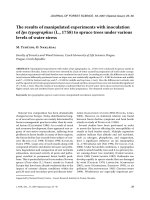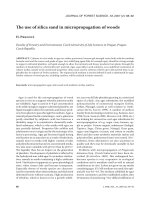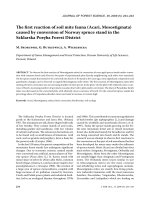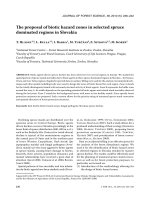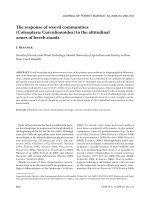Báo cáo lâm nghiệp: "The root-plant ratio changes in the first growing periods of wild cherry (Prunus avium L.) plantations" pptx
Bạn đang xem bản rút gọn của tài liệu. Xem và tải ngay bản đầy đủ của tài liệu tại đây (211.92 KB, 6 trang )
J. FOR. SCI., 53, 2007 (3): 113–118 113
JOURNAL OF FOREST SCIENCE, 53, 2007 (3): 113–118
Artificial regeneration remains the main system
of silviculture in the Czech Republic (A-
2005). Forest Act No. 289/1995 lays down
to perform the regeneration of forest land after
final cut within a 2-year period and to get the new
reforestation in “safe” growing conditions within
7 years after final cut. is underlines the importance
of good growth performance of new plantations
provided that the reforestation is well protected
from harmful biotic and abiotic factors e.g. weed
competition, game browsing, beetle infestation, etc.
e overcoming of “planting shock” is an important
factor where the root system role is substantial (J-
2004b). M and P (2004a) pro-
pose to check the quality and quantity of root system
any time when the new plantation quality is assessed
or checked. e root system of a plant is one of the
driving variables for good performance of reforesta-
tion in forests (M, P 2004b). e idea
of checking the root system is widely accepted for
containerized planting stock (N 2004)
but much less for bare-root seedlings and plants
(J 2004a; M, P 2004a).
ere has been a long tradition in the Czech stand-
ards to fix up the necessary quantitative and quali-
tative parameters for seedlings and plants planted
out. However, until the last Czech standard came
out (J et al. 2002), the root system quality
was not described precisely using the wording like
“the root system should comply with development of
the aboveground part of the plant”. Today the valid
Czech standard requires the root system volume
to correspond to the aboveground volume and this
ratio is given in exact figures. ere is quite a pre-
cise description of quality requirements for planting
stock as well but in this paper we concentrate only
on quantitative parameters of plants.
Published data document different behaviour of
root growth for different species and in different
soil conditions (M et al. 2004c) and therefore
any data on the root system growth of different spe-
cies are an important contribution to the common
knowledge of the basic factor for new plantation
prosperity. For instance M and P
(2004b) found out that the oak root system was
not influenced by the type of regeneration while
the pine root system was significantly determined.
On the other hand, R et al. (2003) reported
that the pine plants given different treatments in
the nursery differed in size at planting out, but they
had similar heights and root system after 3 years in
the forest. This indicates that the root-plant ratio
e root-plant ratio changes in the first growing periods
of wild cherry (Prunus avium L.) plantations
I. K
Faculty of Forestry and Environment, Czech University of Life Sciences Prague, Prague,
Czech Republic
ABSTRACT: e root-plant ratio is one of the important parameters for planting stock quality. We suppose that the ratio
is one of the driving variables for the growth performance of new plantation in the forest. e study summarises data on
the volume of major parts of 4 years old wild cherry trees. An allometric analysis of different parts of plants in relation to
the growth performance of wild cherry trees was done. e results show a close positive relationship between the volume
of the whole root system and aboveground biomass. e same is true of the fine root proportion in the root system. Data
also document that the efficiency of root system is not decreasing during the root development – at least in the investigated
period. e same results were obtained for fine root efficiency. Data confirm the importance of the root-plant ratio for the
growth performance of new plantation in the forest provided that harmful factors are not at a limiting level.
Keywords: regeneration; root system; growth performance of young plantation; wild cherry
114 J. FOR. SCI., 53, 2007 (3): 113–118
is important for growth performance provided
that the nutrient status is not at a growth-limiting
level.
Some studies found out significant differences
between naturally and artificially regenerated young
stands (H, H 2000), other findings indi-
cate that the differences are species specific (M,
P 2004b).
A strong relationship between aboveground bio-
mass and its root system was supported by many
studies (cf. A et al. 2003; J 2004b;
K 2004). An adequate root system is important
also for competition conditions a new plantation will
undergo (A 2002).
The purpose of the present study is to evaluate
the relationship between aboveground biomass and
its root system in terms of fresh volume for a young
plantation of wild cherry trees and to assess the im-
portance of different sections for plant performance
in the forest.
MATERIAL AND METHODS
Research plots of wild cherry plantation were
established in April 2002 at the Training Forest
Enterprise in Kostelec nad Černými lesy near Truba
Research Station. e plots are a part of forest com-
partment 20B9. Generative bare-root plants were
used as a planting stock. e plants were set out
manually into 30 by 30 cm sockets at a 1m spacing.
Regular care of the plantation was done every year
to control weeds. e plots are fenced and thus the
game damage is insignificant.
Site quality could be described according to the
Czech typological system as 2K0 on a flat terrain.
e site quality is not very rich in terms of nutrients
but it is quite a warm site. e site is not favourable
for wild cherry ecological requirements but it is quite
good for successful growing.
e research plot with three replications is about
8 by 8 m in size each. ere were 50 plants on each
research plot at the beginning of the experiment, i.e.
200 plants in total.
Samples of 46 plants were randomly extracted
from all research plots on May 9, 2006. Samples
were cleaned of soil and put into labelled plastic bags
and they were taken into a laboratory for allometric
measurements. ey were deposited in a refrigerator.
e measurements of fresh samples were executed.
e volume of aboveground biomass without leaves,
the volume of whole root system and volume of fine
roots (thinner than 2 mm) were measured in a glass
scaled cylinder filled up with water. e accuracy of
scaled cylinder was 50 mm
3
.
e data were processed by Excel 2003 (11.5 ver-
sion).
RESULTS AND DISCUSSION
e relationship between root system and above-
ground biomass is one of the basic parameters for
seedlings and plants according to the Czech standard
(J et al. 2002). But for the time being there
are not many papers dealing with the root-plant
ratio changes after planting in the forest. ere are
only few data on the influence of the root-plant ra-
tio changes on their growth performance (M,
P 2004a). As the root system is crucial for
the growth of a new plantation, we try to analyze this
relationship from different points of view.
e basic data on the volume of fresh aboveground
biomass, roots and fine roots are given in Table 1.
First of all, we wanted to know if the aboveground
biomass growth was supported by the commen-
surate growth of root system. Fig. 1 shows the
exponential regression in the first period of the
plantation growth in the forest, indicating that the
best aboveground biomass growth is supported by
excellent growth of root system. One can expect that
the exponential growth will not last for a long period
and thus the growth function with upper asymptote
would be more appropriate for regression analysis,
but there are not enough data for that period of plant
development for the time being and available data
gave only poor results for that type of regression.
However, there is a clear trend “the bigger the root
0
20
40
60
80
100
0 10 20 30 40 50 60 7
Root system volume
Plant volume
0
Fig. 1. e relationship of plant to root
system volume in 4 years old wild cherry
plantation (in cm
3
)
J. FOR. SCI., 53, 2007 (3): 113–118 115
system volume, the bigger the plant”, supporting the
requirement of the Czech standard for an adequate
root system volume as one of the preconditions for
good plant performance in the forest. e coefficient
of reliability for exponential regression is very high
explaining 92% of the relationship.
An adequate proportion of fine roots (thinner
than 2 mm) in the root system is another important
parameter of planting stock and thus the changes
in the fine root volume in the first growing periods
of new plantation were also the focus of the study.
e data show a similar relationship between the
fine root volume and the whole root system volume
(see Fig. 2). e exponential curve will not most
probably last for a long period and again the growth
curve would be more appropriate for the regression
if data allow it.
e important role of fine roots for physiological
processes of plants is very well known and thus the
fine root proportion may play a key role for young
plant performance in the forest. e aboveground
biomass volume per unit of fine roots was chosen as
an indicator of their effectiveness. Fig. 3 shows the
relationship between this unit and fine root volume.
Table 1. Data on the volume of fresh plant, roots and fine roots in cm
3
for 4 years old wild cherry plants
Tree number
Plant
(cm
3
)
Roots
(cm
3
)
Fine roots
(cm
3
)
1 32.2 20.7 6.5
2 22.7 14.2 4.9
3 43.2 31.6 8.6
4 85.5 55.0 14.4
5 50.0 39.7 10.6
6 68.5 52.7 11.7
7 29.3 20.2 5.0
8 47.3 40.8 10.8
9 55.5 35.0 10.0
10 79.9 55.1 14.5
11 91.5 57.3 14.9
12 26.6 15.1 3.8
13 77.7 54.4 13.5
14 19.4 8.7 4.55
15 59.9 55.0 13.0
16 73.3 58.8 15.0
17 40.9 30.9 7.6
18 69.7 50.0 10.0
19 87.8 56.6 15.1
20 71.1 53.4 12.7
21 31.7 19.6 5.7
22 83.0 57.5 13.8
23 48.5 39.0 9.6
Tree number
Plant
(cm
3
)
Roots
(cm
3
)
Fine roots
(cm
3
)
24 67.9 44.0 11.5
25 20.8 13.5 3.9
26 60.0 43.5 12.0
27 88.8 57.6 13.9
28 62.2 55.7 14.0
29 36.8 25.8 5.9
30 27.9 15.8 4.8
31 34.8 20.3 6.7
32 17.1 8.0 3.55
33 75.5 59.5 16.0
34 61.5 45.1 9.8
35 30.3 20.0 5.5
36 64.4 45.8 10.8
37 57.7 42.8 11.0
38 81.2 54.7 14.0
39 33.3 25.1 4.9
40 72.8 50.7 11.0
41 58.7 35.7 11.0
42 65.5 43.3 10.5
43 44.8 40.1 9.8
44 51.8 34.8 8.9
45 53.8 35.5 9.9
46 30.8 20.9 6.0
0
5
10
15
20
0 10 20 30 40 50 60 7
Root system volume
Fine root volume
0
Fig. 2. e relationship of fine root to whole
root system volume in 4 years old wild
cherry plantation (in cm
3
)
116 J. FOR. SCI., 53, 2007 (3): 113–118
e data suggest that the fine root ratio is stable
at least in the first growing period of new plantation
and the best growing plants have about the same
fine root ratio as the poorly growing ones. Even the
regression analysis shows an increasing tendency,
the relationship is very poor and the coefficient of
reliability for linear regression is only R
2
= 0.24 and
therefore it could be neglected.
e next step is to evaluate the root-plant ratio
and its relationship with root system as the driving
variable for young plant performance in the forest.
e results are given in Fig. 4. Again, the low coef-
ficient of reliability for linear regression, which is
only R
2
= 0.005, confirms that the root system shows
the same efficiency for the best and poorly growing
plants.
As the first order roots which conduct water and
embed plant into soil are steadily growing and be-
come a relatively bigger part of the root system not
contributing to plant growth, one could expect a
decrease of efficiency with an increase in the root
system volume. is tendency is not evident from
Fig. 4 and from the regression analysis.
Our interpretation of the data is that the efficiency
of root system in terms of plant growth remains
stable at least in that first growing period of plant in
the forest disregarding their functions of conduction
and embedding.
CONCLUSIONS
The root system, namely its architecture and
volume, is the driving variable for growth perform-
ance of young plantations in the forest. is study
concentrates on the root volume and its relation-
ship with plant biomass and effectiveness of plant
components to its growth, neglecting the quality
aspect of roots.
e relationship of plant to root system volume in
4 years old wild cherry plantation is very close. e
coefficient of reliability for exponential regression is
very high explaining 92% of the relationship. It con-
firms that the growth performance of young plants in
the forest is strongly determined by the root system
volume (Fig. 1).
e data show a similar relationship between the
fine root volume and the whole root system volume
(Fig. 2). e aboveground biomass volume per unit
of fine roots was chosen as an indicator of their ef-
fectiveness. Fig. 3 shows the relationship between
this unit and fine root volume. e data suggest that
the fine root ratio is stable at least in the first grow-
ing period of new plantation and the best growing
plants have about the same fine root ratio as the
poorly growing ones.
As the first order roots which conduct water and
embed plant into soil become step by step a bigger
0
1
2
3
4
5
6
7
8
0 5 10 15 20
Fine root volume
Plant/fine root ratio
0.0
0.5
1.0
1.5
2.0
2.5
0 10 20 30 40 50 60 7
Root system volume
Plant/root systam ratio
0
Fig. 3. e relationship between fine root
volume and the ratio of plant to fine roots
in 4 years old wild cherry plantation
Fig. 4. e relationship between root sys-
tem volume and the ratio of plant to roots
in 4 years old wild cherry plantation
Plant/root system ratio
J. FOR. SCI., 53, 2007 (3): 113–118 117
part of the root system not contributing to plant
growth, one could expect a decrease of efficiency
with an increase in the root system volume. is
tendency is not evident from Fig. 4 and from the
regression analysis. In other words, the root system
keeps their efficiency for that period of their life in
the forest.
Our study supports the importance of the rela-
tionship between root system and aboveground
biomass. The root system volume is a driving
variable for the new plantation performance in
the forest and therefore it is important to keep this
parameter as one of the basic parameters for seed-
lings and plants according to the Czech standard
(ČSN 48 2115).
R e fer en ce s
AGESTAM E., EKÖ P.M., NILSSON U., WELANDER
N.T. , 2003. The effects of shelterwood density and site
preparation on natural regeneration of Fagus sylvatica.
Forest Ecology and Management, 176: 61–73.
AMMER CH., 2002. Response of Fagus sylvatica seedlings
to root trenching of overstorey Picea abies. Scandinavian
Journal of Forest Research, 17: 408–416.
ANONYMOUS, 2005. Report on the state of forests and for-
estry in the Czech Republic. Prague, Ministry of Agriculture
of the Czech Republic: 114.
HOLÉN P., HÄNELL B., 2000. Performance of planted and
naturally regenerated seedlings in Picea abies – dominated
shelterwood stands and clearcuts in Sweden. Forest Ecology
and Management, 127: 129–138.
JURÁSEK A. et al., 2002. ČSN 48 2115/Z1 Sadební materiál
lesních dřevin. Praha, ČNI: 25.
JURÁSEK A., 2004a. Kořenový system vegetativně množených
lesních dřevin. In: Kořenový systém – základ stromu.
Sborník z konference MZLU, 25. 8. 2004. Křtiny: 137–
149.
JURÁSEK A., 2004b. Dosavadní zkušenosti s použitím KSM
buku z intenzivních technologií. In: Možnosti použití sadeb-
ního materiálu z intenzivních školkařských technologií pro
obnovu lesa. Sborník z konference VÚLHM, 3–4. 6. 2004.
Opočno: 57–64.
KUPKA I., 2004. Vliv způsobu výsadby na kořenový systém
bukových sazenic. In: Hlavní úkoly pěstování lesů na
počátku 21. století. Sborník z mezinárodního vědeckého
sympozia MZLU, září 2004. Brno: 129–138.
MAUER O., PALÁTOVÁ E., 2004a. Deformace kořenového
systému – vznik a možnosti eliminace. In: Kořenový systém
– základ stromu. Sborník z konference MZLU, 25. 8. 2004.
Křtiny: 85–91.
MAUER O., PALÁTOVÁ E., 2004b. Vývin kořenového
systému lesních dřevin z umělé a přirozené obnovy. In:
Kořenový systém – základ stromu. Sborník z konference
MZLU, 25. 8. 2004. Křtiny: 115–124.
MAUER O., PALÁTOVÁ E., RYCHNOVSKÁ A., 2004c.
Porosty náhradních dřevin a jejich kořenový systém. In:
Kořenový systém – základ stromu. Sborník z konference
MZLU, 25. 8. 2004. Křtiny: 75–84.
NÁROVCOVÁ J., 2004. Zkušenosti s hodnocením kvality
kořenového systému sadebního materiálu lesních dřevin.
In: Kořenový systém – základ stromu. Sborník z konference
MZLU, 25. 8. 2004. Křtiny: 103–114.
RYTTER L., ERICSSON T., RYTTER R.M., 2003. Effects
of demand-driven fertilization on nutrient use, root:
plant ratio and field performance of Betula pendula and
Picea abies. Scandinavian Journal of Forest Research, 18:
401–415.
Received for publication August 7, 2006
Accepted after corrections September 27, 2006
Vývoj poměru objemu kořenového systému a nadzemní části v prvních fázích
výsadby třešně ptačí (Prunus avium L.)
ABSTRAKT: Objemový poměr kořenového systému k nadzemní části je jedním z hlavních kvalitativních parametrů
sazenic. Předpokládáme, že je tento poměr jednou z určujících veličin pro ujímavost a růst nových výsadeb v lese. Pří
-
spěvek shrnuje data o vývoji čtyřletých sazenic třešně ptačí. Byla provedena analýza alometrických vztahů důležitých
částí sazenic k růstu a vývoji výsadby. Výsledky ukázaly signifikantní vztah mezi objemem kořenového systému
a nadzemní částí rostliny. Totéž platí o podílu jemných kořenů. Z dat rovněž vyplývá, že efektivita kořenového systému
neklesá během zvětšování jeho objemu – alespoň v této fázi vývoje výsadeb. Totéž lze tvrdit i o efektivitě jemných
118 J. FOR. SCI., 53, 2007 (3): 113–118
Corresponding author:
Doc. Ing. I K, CSc., Česká zemědělská univerzita v Praze, Fakulta lesnická a environmentální,
165 21 Praha 6-Suchdol, Česká republika
tel.: + 420 224 383 791, fax: + 420 224 377 917, e-mail: kupka@fle.czu.cz
kořenů. Data potvrdila významnost objemového poměru kořenového systému k nadzemní části rostlin pro jejich
vývoj a růst po výsadbě za předpokladu, že nedochází k významnému poškozování těchto výsadeb.
Klíčová slova: obnova lesa; kořenový systém; růst a vývoj výsadeb; třešeň ptačí
